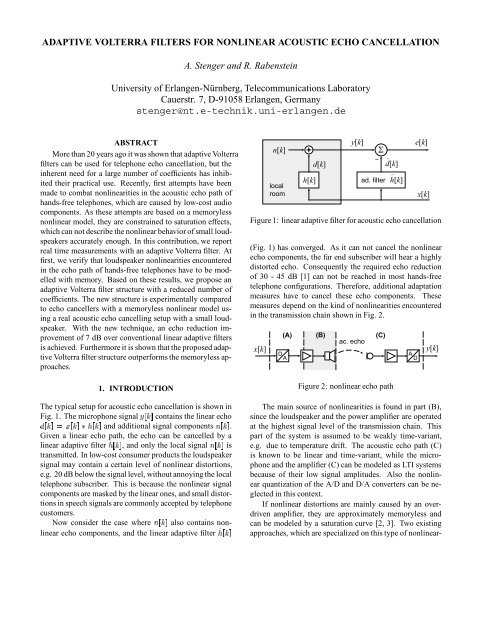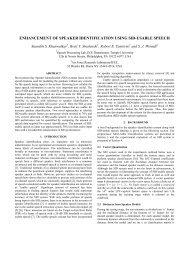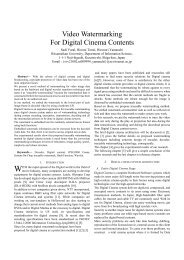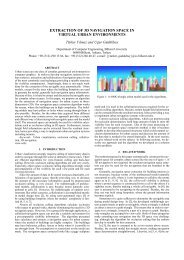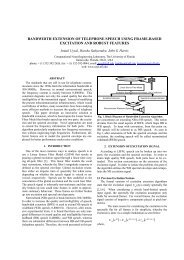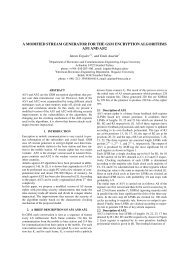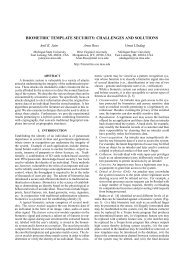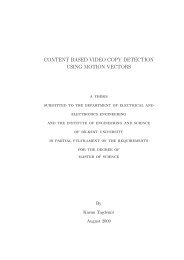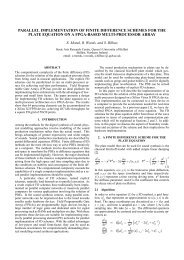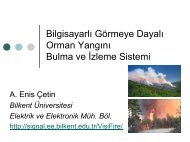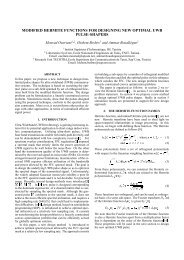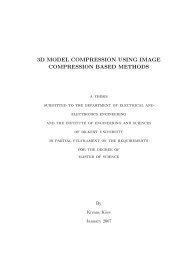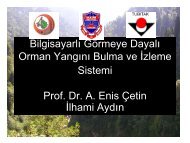Adaptive Volterra filters for nonlinear acoustic echo cancellation
Adaptive Volterra filters for nonlinear acoustic echo cancellation
Adaptive Volterra filters for nonlinear acoustic echo cancellation
- No tags were found...
Create successful ePaper yourself
Turn your PDF publications into a flip-book with our unique Google optimized e-Paper software.
<strong>nonlinear</strong> <strong>echo</strong> pathy[k]x[k]–hˆ1NLMSh 0–hˆ(tr)2delaye[k]NLMS-15 dB, i.e. they are well audible, but might be just tolerable<strong>for</strong> low cost applications. For this type of <strong>nonlinear</strong>ityboth schemes allow a further <strong>echo</strong> reduction by 4-5 dB, seecurves (2) and (3).ERLE [dB]2015105(3)(2)(1)Figure 5: New <strong>nonlinear</strong> <strong>acoustic</strong> <strong>echo</strong> cancellerIts elements are equivalent to those of ^h2[k] with indices 1 ; 2 < +M 2 . As the DC component of the inputsignal is correlated with the second order excitation, normalization<strong>for</strong> these two components is per<strong>for</strong>med in common,i.e. 2 0 = 2 =kx2[k]k 2 2 +1 (9)where the 1 in the denominator accounts <strong>for</strong> the DC componentand can be omitted, if no DC coefficient is implemented.4. EXPERIMENTAL RESULTSThe new system has been tested with different low costspeakers between 0:1 and 0:4 Watts and a one-chip amplifierplaced in an enclosure with low reverberation. As excitationx[k] white Gaussian noise was used. The amplitudewas chosen so that the amplifier is not highly overdriven andloudspeaker <strong>nonlinear</strong>ities dominate over saturation effects.We compare different <strong>nonlinear</strong> <strong>echo</strong> cancelling approacheswith a linear adaptive filter in terms of the Echo Return LossEnhancementERLE = Efy2 [k]gEfe 2 [k]g :The steady-state ERLE of the linear filter is a coarse measureof the <strong>nonlinear</strong> distortion ratio within the loudspeakersignal, which is percieved by the near-end user in the localroom.4.1. Systems with memoryless <strong>nonlinear</strong>ityThe behaviour of the systems described in Sec. 2 is compared<strong>for</strong> two situations: in Fig. 6 the <strong>nonlinear</strong>ity in the<strong>echo</strong> path contains mainly saturation effects due to a loweredamplifier supply voltage. As the linear adaptive filter(1) can reduce the <strong>echo</strong> only by 15 dB, the <strong>nonlinear</strong>distortions contained in the loudspeaker signal are at about00 1 2 3 4 5time [seconds]Figure 6: Saturation effect: Memoryless <strong>nonlinear</strong>ity is appropriatemodelIn Fig. 7 the amplifier was not overdriven, and there<strong>for</strong>eloudspeaker <strong>nonlinear</strong>ities dominate. In this case the memoryless<strong>nonlinear</strong> <strong>echo</strong> cancellers (2) and (3) do not improvethe <strong>echo</strong> reduction compared to a linear adaptive filter (1).4.2. <strong>Adaptive</strong> <strong>Volterra</strong> FilterFig. 7 shows a comparision between a conventional linear<strong>acoustic</strong> <strong>echo</strong> canceller with NLMS algorithm (1) with M 1 =250 coefficients, both memoryless <strong>nonlinear</strong> <strong>echo</strong> cancellers(2) and (3), and the new system (4) with =17, M 2 =25. The additional computational load of the second order<strong>Volterra</strong> kernel is 3 2 M 2 2 + 3 2 M 2 +2, if symmetry is exploited,while the linear NLMS adaptive filter costs 2M 1 +2multiplications per sample. In our example we have 977 additionalmultiplications/sample due to the 2nd order kernel,while the linear filter costs 502 multiplications/sample.ERLE [dB]3530252015(4)(2)(1)(3)100 1 2 3 4 5time [seconds]Figure 7: Loudspeaker <strong>nonlinear</strong>ity: 2nd order <strong>Volterra</strong> filteris suitableComparing curves (1) and (4) shows, that convergencespeed is not lowered through the additional second orderkernel, and steady state ERLE is 5 dB higher. With largermemory M 2 =35up to 7 dB can be gained.
4.3. Effect of a DC offset in the microphone signalOften y[k] or x[k] have a small DC offset due to A/D conversion.Here we discuss the need <strong>for</strong> an adaptive DC coefficienth 0 , and claim that <strong>for</strong> a fair comparision betweenlinear and <strong>nonlinear</strong> adaptive <strong>filters</strong> the DC components ofx[k] and y[k] have to be removed.The following experiment has been per<strong>for</strong>med with thesame setup as above, but a small DC offset, which originallyoccured in y[k], has not been removed. Fig. 8 showsthat the per<strong>for</strong>mance of the linear filter is degraded throughthe DC offset, and only 25 dB ERLE can be reached. However,if an adaptive DC coefficient is addded to the system,i.e. we adapt h 0 and h1 in parallel, this problem can becircumvented, and the expected 28 dB ERLE are reached,as with the linear filter in Fig. 7. The upper two curves inFig. 8 result with a 2nd order <strong>Volterra</strong> filter. They show thatthe use of an adaptive DC coefficient h 0 does not significantlyimprove the model acuracy. From this we conclude,that a second order <strong>Volterra</strong> filter can model a DC componentto a certain extent, and there<strong>for</strong>e an additional adaptiveDC coefficient h 0 is not required in the <strong>nonlinear</strong> <strong>echo</strong> pathmodel.ERLE [dB]352515no DC coeff.with DC coeff.50 1 2 3 4 5time [seconds]Figure 8: Apative <strong>echo</strong> <strong>cancellation</strong> with and without DCadaptive coefficientFurther we can see, that it is important to exclude theeffects of a possible DC offset in x[k] and y[k], if a secondorder adaptive <strong>Volterra</strong> filter is compared to a linear adaptivefilter in the context of second order loudspeaker <strong>nonlinear</strong>ities.Otherwise we would measure a higher ERLEdifference than could be gained by modelling second order<strong>nonlinear</strong>ities of a loudspeaker. To ensure a fair comparisionin the experiments of Sec. 4.1 and 4.2, we there<strong>for</strong>eremoved any DC offset in the signals x[k] and y[k].5. SUMMARYThe per<strong>for</strong>mance of linear <strong>acoustic</strong> <strong>echo</strong> cancellers is limitedby <strong>nonlinear</strong> components in the <strong>echo</strong> path. Existing<strong>acoustic</strong> <strong>echo</strong> cancellers <strong>for</strong> memoryless <strong>nonlinear</strong>ities arespecialized <strong>for</strong> saturation effects and cannot model loudspeaker<strong>nonlinear</strong>ities accurately enough. We showed thata second order adaptive <strong>Volterra</strong> filter is suitable <strong>for</strong> <strong>echo</strong><strong>cancellation</strong> in such cases, and a DC coefficient needs notto be incorporated into the model, even if there is a smallDC offset in the microphone signal. Two normalizationschemes <strong>for</strong> the LMS algorithm have been discussed, anda design rule <strong>for</strong> the choice of the relevant coefficients wasproposed to reduce the computational load. Practical implementationsof systems with different small loudspeakersoperated at their power limit have been investigated. Forsituations, where memoryless <strong>nonlinear</strong> models could notimprove <strong>echo</strong> reduction, the new system achieves an <strong>echo</strong>reduction gain up to 7 dB over linear adaptive <strong>filters</strong>. Withonly modest computational load, moer than 5 dB are gained.6. REFERENCES[1] International Telecommunication Union, “General characteristicsof international telephones connections and internationaltelephone circuits – <strong>acoustic</strong> <strong>echo</strong> controllers,” ITU-TRecommendation G.167, 1993[2] A. Stenger, R. Rabenstein, “An Acoustic Echo CancellerWith Compensation of Nonlinearities,” Proc. EUSIPCO 98,Isle of Rhodes, Greece, September 1998, pp. 969-972[3] Bryan S. Nollet, Douglas L. Jones “Nonlinear Echo CancellationFor Hands-Free Speakerphones,” Proc. NSIP'97,September 8-10, 1997, Michigan USA[4] Franklin X.Y. Gao, W. Martin Snelgrove, “<strong>Adaptive</strong> Linearizationof a Loudspeaker,” Proc. ICASSP 91, pp. 3589-3592.[5] A. N. Birkett, R. A. Goubran, “Acoustic Echo CancellationUsing NLMS-Neural Network Structures”, Proc. ICASSP1995, Detroit, MI, pp. 2035-3038[6] E.J. Thomas, “Some considerations on the application ofthe <strong>Volterra</strong> representation of <strong>nonlinear</strong> networks to adaptive<strong>echo</strong> canceller,” Bell Systems Technical Journal, Vol 50, No.8, October 1971, pp 2797-2905.[7] Samuel D. Widrow, Bernard Stearns: “<strong>Adaptive</strong> Signal Processing,”Prentice Hall, Englewood Cliffs, New Jersey, 1985[8] Martin Schetzen, “The <strong>Volterra</strong> and Wiener Theories of NonlinearSystems,” Wiley and Sons, New York, 1980[9] V. John Mathews, “<strong>Adaptive</strong> Polynomial Filters,” IEEE SignalProcessing Magazine, 8(3), pp.10-26, July 1991[10] E. Hänsler, “From Algorithms to Systems – It's a RockyRoad,” Proc. IWAENC'97, London, Sept. 11-12, 1997, pp.K.1 - K.4[11] Martin J. Reed, Malcom O. Hawks<strong>for</strong>d, “Practical Modellingof Nonlinear Audio Systems Using the <strong>Volterra</strong> Series,”100th covention of AES, Copenhagen, May 11-14,1996, Preprint 4264 (R-2)


